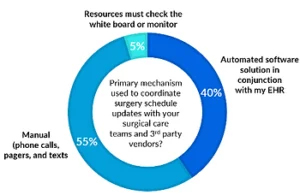RelayOne recently commissioned in90group Research to conduct an independent survey of more than 100 health system leaders regarding the performance of their surgical services teams and facilities.
The research revealed that most leaders (96%) believe there is much room for improvement when it comes to the efficiencies and performance of their surgical services. In fact, the survey shows that most believe their operating rooms are running at 20-30% lower utilization rates than they should be.
Since surgical services typically represent 60% of a health system’s revenue and many are working to regain their financial footing in a post-pandemic environment, now is the time for leaders to explore new ways to create greater efficiencies and improve the performance of their operating rooms (OR).
The Impacts
When asked to identify the biggest impact of sub-optimal performance in the OR, the sample of business and technical leaders identified increased overtime expenses (36%), declining surgical staff satisfaction (31%), and lost revenue due to surgery delays and coordination (20%). These pain points tend to exacerbate issues like staff shortages and financial shortfalls.
When asked what the most urgent issues their teams are hoping to address in the next 12-18 months, the top issues were similar among both business and technical leaders, with 42% of business leaders saying operational efficiency is their number one issue and 36% of technical leaders looking to boost cost efficiencies.
Enabling better performance from this revenue center has taken on some urgency for a large majority of survey respondents, 87% of whom said they are missing out on revenue opportunities due to inefficiencies. 77% said they are planning to start an initiative to improve performance and efficiencies of their ORs in the near future.
A Place to Start – Surgical Care Team Coordination
Only 26% of survey respondents felt that coordination among their surgical care teams were optimized, leaving 74% looking for improvement in this area. It’s no surprise, given the fact that a typical surgical team includes 15 to 20 members who must function as one cohesive unit, all on the same page and knowing exactly what is going on when.
The operating room is a fast-changing environment, and therefore optimizing surgical team coordination is key to improving OR efficiencies and performance.
Communications appear to be a particularly weak link, with 55% of respondents reporting they still depend on outdated mechanisms, like phone calls and pagers, as their primary means to coordinate with care team members and third-party vendors critical to surgeries. These modes often require multiple contacts for every addition or change, compounding the labor around team coordination.

Others (40%) have implemented an automated software solution to coordinate surgery schedule updates. However, 77% of that group depend on their electronic health record (EHR) system, one that is not designed to communicate with non-clinical or third-party resources, like medical device vendors, who are often critical to successful surgeries. Environmental staff, necessary for efficient room-turns, are also left out.
These outdated communication mechanisms and inadequate systems leave hospitals vulnerable to work
arounds that often require exposing patients’ personal health information (PHI) via a schedule board or
screen, putting them at risk of HIPAA violations.
A Deceptively Simple Solution
The research also shows consistency among the viewpoints of these 100 health leaders: ORs are not as efficient as they could be and the issue must be addressed.
With hospitals having spent billions on modern equipment and new facilities to accommodate more surgeries and a better patient experience, the survey shows the fundamental problem of optimizing what they already have remains.
Real-time communication solutions that connect everyone and are easy to access, easy to use, and which protect PHI are the missing link. When the right team members are in the right place at the right time with the right information, more cases can be completed more quickly while preserving quality care. This starts a cycle of consistent improvements that can increase case capacity, improve team member satisfaction and ensure a positive and safe patient experience.
Learn more about how your peers view the challenges around OR efficiency and utilization. Read the full research report here: Surgical Services Research: Insights for 2022